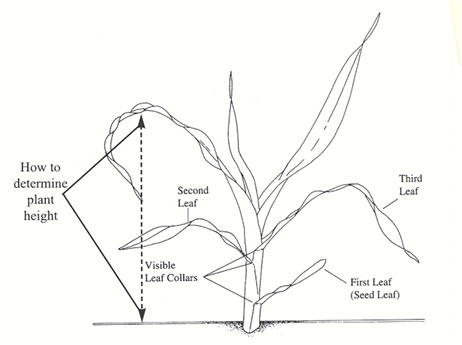
Precision Ag
Determining leaf stage in corn
Knowing what leaf stage your corn crop is at is extremely important since post emergent herbicides can only be applied to corn up to the label-specified leaf stage. Therefore, both farmers and agronomists need to accurately stage corn plants.
Herbicide labels often refer to plant height, crop growth stage (leaves or collars), or both when discussing corn growth stage limits for the application of postemergence herbicides. Below is a review of some common methods for determining growth stage. It is important to know which method the herbicide manufacturer is using to indicate correct herbicide application timing. For each method, the stage of the corn plant in Figure 1 will be determined.
Corn Height Method. To determine corn plant height, measure from the soil surface to the highest point of the arch of the uppermost leaf whose tip is pointing down. Don't measure to the "highest point" on the plant, which is often the tip of the next emerging leaf above. Refer to Figure 1 on how to correctly determine the height of a corn plant.
Both environmental and management conditions can have a great impact on the height of a corn plant. In cool, wet springs, corn often grows more slowly from a height standpoint but it is still advancing physiologically. A delayed seeding date, differences in tillage, and differences in soil type can also have a pronounced effect on plant height but relatively little effect on the stage of vegetative development. Hybrid can also have an effect on plant height as shorter-season hybrids tend to produce shorter plants. Because corn height varies a great deal due to growing and crop management conditions, it is not the most accurate way to stage corn plants.
Leaf Over Method. The leaf over method is a common way of measuring leaf number. The leaf over method counts the number of leaves, starting from the lowest one (the coleoptile leaf which has a rounded tip) up to the last leaf that is arched over (tip is pointing down). Do not count leaves younger (inside) than this one, even though they are present in the whorl. In Figure 1, the corn plant would be at the 4 leaf stage.
Leaf Collar Method (V-stage). The leaf collar method is generally the easiest to use. It also relates better to the physiological stage of the plant and thus to the effects of herbicides. Staging by the leaf collar method is done by counting the number of leaves with visible collars, beginning with the lowermost, short, rounded-tip true leaf and ending with the uppermost leaf with a visible leaf collar. Collars are not visible until the leaves are developed enough to emerge from the whorl. In Figure 1, the corn plant would be at 3 leaf stage (V3).
Staging Corn with Severe Leaf Damage. Dead leaf tissue will not resurrect itself and will eventually slough off as the plants continue to grow. The question is whether the leaf stage of a recovered plant begins anew with the healthy leaves or whether the dead leaves (which may no longer be visible) should be counted. In other words, should a 3-leaf plant that has lost 2 leaves to frost injury now be considered a 1-leaf plant?
The simple answer is: If corn was a 3-leaf plant prior to the frost, physiologically it still is a 3-leaf corn plant after the frost, no matter how many lower leaves are damaged, dead, or otherwise missing.
May 29, 2015 By Pam de Rocquigny Provincial Cereal Crops Specialist MAFRD
 Knowing what leaf stage your corn crop is at is important since post emergent herbicides can only be applied to corn up to the label-specified leaf stage.
Knowing what leaf stage your corn crop is at is important since post emergent herbicides can only be applied to corn up to the label-specified leaf stage.